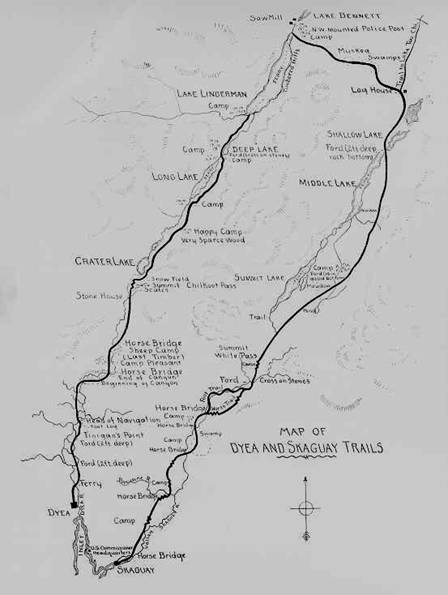The trail to The Klondike Gold Fields
Skagway and Dyea were the starting off point for two of the trails that lead over the coastal mountain ranges to the Klondike Gold Fields. Two separate and dangerous trails that became famous during the gold rush years of 1897 and 1898. These trails took many lives and vanquished the high hopes of those that decided to seek their fortunes searching for gold. The law required anyone entering the area to have supplies for a year. That meant about one ton of supplies for every stampeder. It also meant that the stampeders walked 80 miles for every single mile they moved their possessions. Up and down the trail taking as much of their supplies as they could carry each time.

The Seattle Post-Intelligencer published this map to the gold fields in 1897. It shows the Dyea (Chilkoot Pass) trail on the left and the Skagway (White Pass) trail on the Right.
White Pass trail was 2865 feet high and 15 miles from the mouth of the Skagway River. It began in Skagway and led inland to Lake Bennett. The White Pass trail seemed deceptively easy. The first few miles were wide enough for wagons, but as the trail wound through the hills, the pathway narrowed to little more than two feet across. As it rose, the sharp zigzag turns of the trail were boarded on one side by a hill, and dropped hundreds of feet down on the other.
The trail out of Skagway had originally been advertised as an all-wagon trail. With such a smooth and easy beginning, people who set out on the trail had little reason to doubt that their mules, oxen and horses could carry their goods all the way over the pass to Lake Bennett. But when the trail narrowed, and there was no room for animals or people to pass, the line bunched together in gridlock. It is estimated that more than 3,000 horses died as a result for their owners trying to get them and their supplies over these trails. Some people began calling this the “Deadhorse Pass” due to the decaying bodies of horses left along the trail.
The rival trail was the Chilkoot pass trail. This trail was slightly higher and it started in Dyea at the mouth of the Taiya River with a destination 32 miles later of Lake Lindeman. It even had the “Golden Stairs” carved out of ice for getting up the pass and the “Chutes” for getting back down. While most of the trail was not too difficult for walking, Long Hill, the 2 1/2-mile section between Sheep Camp and Scales ascended 1,600 feet, from about 900' to 2500'. Sheep Camp was the last "town" of any substance that the stampeders would see until they reached Lake Bennett. By 1898, Sheep Camp boasted dozens of tents and a few log buildings. Here, restaurants, saloons and hotels lined the trail.
It was at Lake Lindeman and Lake Bennett that they waited for the spring thaw and spent their time attempting to build boats for the trip on the Yukon River.
Most stampeders crossed over the Dyea and Skagway trails. The two towns competed with each other for stampeders (and their money) by claiming to have the easiest passage into the Klondike. A deadly avalanche on the Chilkoot Pass killed dozens and allowed Skagway to boast that the White Horse Pass was safer. In truth, neither pass was easy. Winter travel meant thick snow and treacherous ice. In the spring and fall, stampeders, animals, wagons and sleds had to slog along through thick, unending mud. Even those who were fortunate enough to travel during the summer had to pick their way along trails littered with sharp, jagged rocks.
The competition for stampeder dollars continued in Dyea and Skagway, Alaska, the towns at the trail heads for the two most popular routes over the mountains, the Chilkoot Pass and the White Pass. Both towns could be reached by ship and were less than 10 miles apart.
Dyea and Skagway's rivalry was brief, but heated. Even though the Chilkoot Pass (through Dyea) was the most popular trail, Skagway was always the larger town. In the first half of 1898, when Skagway was teeming with stampeders, it was the biggest town in Alaska. All this changed when the first portion of the White Pass and Yukon Railroad was finished in July 1899, linking Skagway and Lake Bennett. By then, however, the majority of the stampeders were already in the gold fields.
Skagway flourished but nearby Dyea is lost to the ages.
